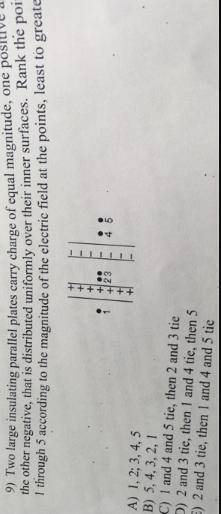
Two large insulating parallel plates carry charge of equal magnitude, one positive and the other negative, that is distributed uniformly over their inner surfaces. Rank the points 1 through 5 according to the magnitude of the electric field at the points, least to greatest.
A. 1, 2, 3, 4, 5
B. 2, then 1, 3, and 4 tied, then 5
C. 1, 4, and 5 tie, then 2 and 3 tie
D. 2 and 3 tie, then 1 and 4 tie, then 5
E. 2 and 3 tie, then 1, 4, and 5 tie

Answers: 3


Another question on Physics

Physics, 21.06.2019 20:00
Player kicks a soccer ball from ground level and sends it flying at an angle of 30 degrees at a speed of 26 m/s. what is the horizontal velocity component of the ball to the nearest tenth of a m/s?
Answers: 2

Physics, 21.06.2019 22:30
Follow these directions and answer the questions. 1. shine a pencil-thin beam of light on a mirror perpendicular to its surface. (if you don't have a laser light as suggested in the video, you can make a narrow beam from a flashlight by making a cone from black construction paper and taping it over the face of the flashlight.) how does the light reflect? how does the relationship of incident to reflected ray relate to the reflection of water waves moving perpendicular to a barrier? 2. shine a pencil-thin beam of light on a mirror standing on a sheet of paper on the table (or floor) so that you can mark the incident ray and reflected ray. (you can support the mirror from the back by taping it to a wooden block.) 3. mark a line on the paper representing the reflective surface. (the reflective surface of a mirror is usually the back edge.) 4. draw a dashed line perpendicular to the mirror surface at a point where the incident and reflected ray meet. this perpendicular is called a normal to the surface. 5. measure the angles between the rays and the normal. the angle of incidence is the angle formed by the incident ray and the normal to the surface. the angle formed by the reflected ray and normal is called the angle of reflection (r). what is the angle of incidence? what is the angle of reflection? 6. repeat for several different angles. (see report sheet for details.) what appears to be the relationship between the angle of incidence and angle of reflection? in science 1204, what was the relationship for these two angles made by the reflection of waves in a ripple tank? 7. roll a ball bearing so that it hits a fixed, hard surface (a metal plate) at several angles (including head-on). observe the way in which the ball bearing reflects. what generalization can you make about how a ball bearing reflects from a wall? have you proved that light can only behave like a wave?
Answers: 1


Physics, 22.06.2019 12:30
Consider a hydrogen atom in the ground state. what is the energy of its electron? =e= jj now consider an excited‑state hydrogen atom. what is the energy of the electron in the =5n=5 level? =e5= j
Answers: 3
You know the right answer?
Two large insulating parallel plates carry charge of equal magnitude, one positive and the other neg...
Questions

Mathematics, 01.02.2021 19:40


English, 01.02.2021 19:40

English, 01.02.2021 19:40

History, 01.02.2021 19:40


History, 01.02.2021 19:40

Mathematics, 01.02.2021 19:40



Mathematics, 01.02.2021 19:40



Geography, 01.02.2021 19:40

History, 01.02.2021 19:40

Mathematics, 01.02.2021 19:40




Mathematics, 01.02.2021 19:50




